Optimal Flooring Solutions for Chicken Houses


Intro
When it comes to poultry management, the floor of a chicken house plays a pivotal role, often overlooked yet fundamental to the health and well-being of the birds. Selecting the right flooring isn’t just a matter of aesthetics or ease of cleaning; it can significantly impact everything from the chickens’ comfort and mobility to the efficiency of your operation. Whether you're managing a large-scale commercial poultry operation or a modest backyard coop, making informed decisions regarding flooring can lead to healthier flocks and more productive yields.
In this exploration, we will dissect the options available for chicken house flooring, diving into the advantages and drawbacks of various materials. Understanding the maintenance needs, assessing sustainable practices, and evaluating the overall impact on poultry health stand central to this discourse. Let’s roll up our sleeves and get into the nitty-gritty of flooring solutions that cater specifically to the dynamic world of chicken husbandry.
Intro to Chicken House Flooring
The flooring within chicken houses might seem like a small fry within the vast universe of poultry management, yet it plays a pivotal role in ensuring the health and productivity of your flock. In fact, the right flooring solution can be the difference between clucking bliss and a real headache. First things first, the flooring has a significant impact on bird behavior, hygiene, and overall well-being. When set up correctly, it can promote natural behaviors, such as scratching and dust bathing, contributing to happier, healthier birds.
Importance of Flooring in Poultry Management
When diving into the nitty-gritty of poultry management, it becomes clear that flooring isn't just a surface underfoot—it's the bedrock of successful chicken raising. Poorly chosen flooring can lead to a host of issues, from foot problems due to rough surfaces to increased risk of diseases fostered in unsanitary conditions. What's more, flooring that is easy to clean can save you time and effort, ultimately reflecting on your farm's productivity. For instance, dirty or damaged flooring can lead to higher pathogen loads, putting your flock at risk.
Here are vital factors to keep in mind regarding the importance of flooring:
- Health and Comfort: The right flooring can prevent conditions like bumblefoot and other foot injuries, promoting better welfare overall.
- Hygiene: Easy-to-clean materials help maintain a sanitary environment, reducing the risk of disease outbreaks.
- Efficiency: With the right flooring, maintenance becomes a breeze, allowing you to focus on other essential farming tasks instead of mopping up messes.
Overview of Flooring Options
In today's market, poultry keepers have an array of flooring options at their fingertips. The choices can make one's head spin, but understanding each material's unique properties make decision-making a tad easier. Generally, flooring can be broadly categorized into natural and synthetic materials, each coming with distinct perks and quirks.
- Natural Materials: These are often favored for their accessibility and biodegradability. Common options include:
- Synthetic Materials: These usually offer more durability and ease of cleaning. Popular synthetics include:
- Wood Shavings: Highly absorbent, they promote a dry and comfortable environment.
- Straw: A traditional choice that provides insulation but requires regular changes to avoid mold.
- Sand: Economical and easy to maintain; however, it may not suit every climate.
- Plastic Mesh: Designed for drainage, allowing waste to fall through, thereby maintaining cleanliness.
- Concrete Slabs: Known for their durability, though they require good drainage to avoid pooling water.
- Vinyl Flooring: Providing excellent resistance to stains, this option offers both hygiene and comfort when properly laid out.
Ultimately, the choice of flooring comes down to individual farm needs, local climate, and the specific care you wish to provide for your chickens. Selecting the right flooring can make all the difference not only in managing workloads but also in ensuring your poultry feels at home in their coop.
Types of Flooring Materials
Choosing the right flooring materials for chicken houses is like picking the right pair of shoes for a long journey; it can significantly impact both comfort and performance. Each flooring option comes with its own set of benefits and drawbacks, and understanding these differences is paramount for anyone looking to optimize their poultry management practices.
Selecting flooring materials influences various aspects such as hygiene, animal comfort, and overall management effectiveness. From natural options like straw and wood shavings to synthetic varieties like plastic mesh and vinyl flooring, the landscape is diverse. Knowing the pros and cons of these materials not only helps in making informed decisions but also ensures a productive and healthy environment for the chickens.
Natural Materials
Wood Shavings
Wood shavings can truly be a game-changer when it comes to chicken house flooring. They are light, absorbent, and relatively inexpensive. Their key characteristic is their ability to absorb moisture and odor, which can keep the environment fresh and reduce the risk of respiratory illnesses among the birds.
A unique feature of wood shavings is that they can break down over time into compost, which can be utilized as fertilizer. However, it’s worth noting that they can pose a fire risk if not managed properly. Regular replacements are necessary to maintain hygiene, making wood shavings a viable yet maintenance-heavy option.
Straw
Straw is another popular natural flooring material, favored for its availability and affordability. Its soft texture creates a comfortable sleeping surface for chickens, contributing positively to their welfare. The main appeal of straw lies in its insulation properties, offering warmth during chilly nights.
Yet, straw does have its downsides. It can be prone to mold growth if it becomes damp, potentially leading to health issues for the poultry. So, while it's an economical choice, poultry keepers must monitor moisture levels closely to avoid complications.
Sand
Using sand as flooring is gaining traction among progressive poultry owners. One of its most significant advantages is its ease of cleaning; it can be raked and sifted to remove waste easily, thus maintaining a healthier environment for the flock. Moreover, sand provides excellent drainage, reducing the risk of mud and associated diseases.
However, a consideration with sand flooring is its lack of insulation. In colder climates, it might not provide enough warmth, leading to discomfort for the birds. This calls for a careful assessment of the local climate before choosing sand as a flooring option.
Synthetic Materials
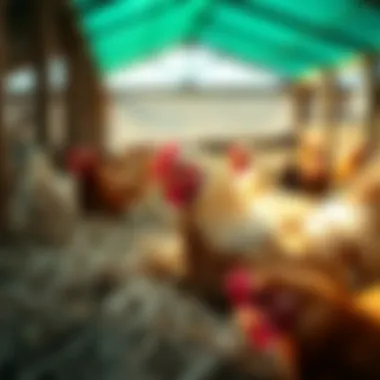
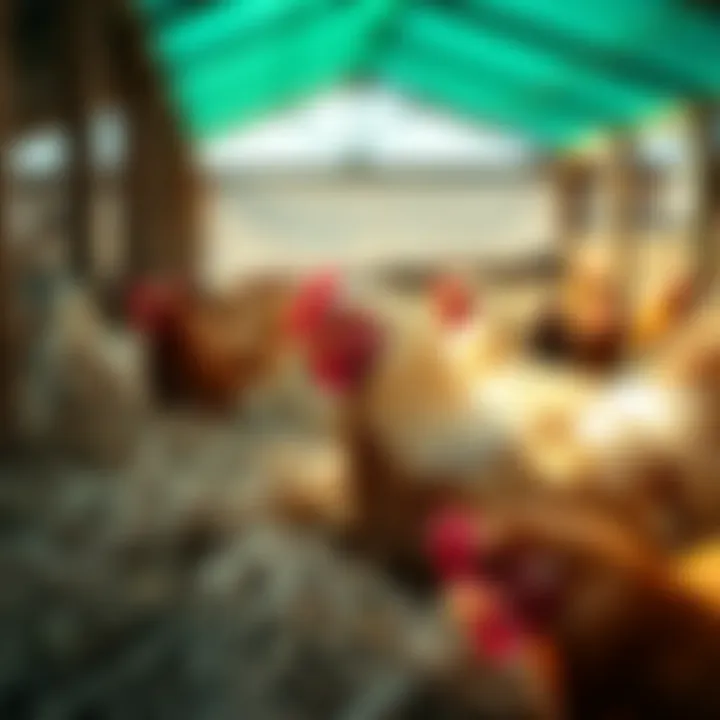
Plastic Mesh
Plastic mesh is becoming a go-to option for many poultry keepers due to its durability and ease of maintenance. This synthetic flooring allows for excellent drainage, which helps maintain a clean environment. Its key characteristic is its resilience against wear and tear; it lasts much longer than many natural alternatives.
One notable feature of plastic mesh is its light-weight nature, which simplifies installation. Nevertheless, it is essential to choose high-quality mesh since inferior versions may become brittle over time. Also, they can be slippery for birds, potentially leading to injuries if not monitored carefully.
Concrete Slabs
Concrete slabs offer a hard-wearing solution for chicken houses and are often considered a long-term investment. They provide excellent durability and easy cleaning, two significant advantages for poultry operations that prioritize hygiene.
However, the downside of concrete is its coldness and hardness; without adequate bedding, it may create a less-than-ideal environment for chickens. Careful management of bedding materials is needed to ensure comfort.
Vinyl Flooring
Vinyl flooring has made its way into poultry houses due to its versatility and ease of cleaning. It is resistant to water and mess, which can save time and effort in upkeep. One of the essential qualities of vinyl flooring is its cushioned surface, offering some comfort to the chickens as they move about.
On the flip side, vinyl flooring can be prone to punctures if sharp objects are used or dropped on it. Though replacement parts are relatively easy to find, it’s an added expense that must be considered. Furthermore, poorly installed vinyl may trap moisture beneath it, leading to mold growth over time.
Choosing the right flooring material is a nuanced decision, requiring careful thought and consideration of both the benefits and challenges associated with each option. By understanding these intrinsic qualities, poultry keepers can pave the way for healthier, more productive flocks.
Benefits of Various Flooring Types
Selecting the right flooring for a chicken house can make a world of difference in managing your flock. The benefits derived from various flooring types range from overall hygiene to the insulation needed for livestock comfort. Flock health and productivity are closely connected to the flooring chosen, a fact that cannot be overstated. Here, let's delve into the specific advantages of different flooring types, looking closely at how each contributes to the vitality of poultry operations.
Ease of Cleaning and Maintenance
One of the paramount advantages of well-selected flooring is its impact on cleaning and maintenance. It isn't just about how the floor looks. The ease with which a flooring type can be cleaned directly influences the general health conditions within the chicken house.
- Natural Materials often break down and create a layer of compost, which can be beneficial, but this can also lead to increased mess if not managed properly. Consider a deeper layer of sand; it allows for easy sifting and cleaning while promoting natural behaviors in the birds.
- Synthetic Materials such as plastic mesh provide a smooth and non-porous surface, making cleaning a breeze, while concrete slabs require less daily effort but may need handpicking droppings and debris. Overall, efficient cleaning can help minimize health risks, such as infections, and keeps the environment livable for both the birds and farm operators.
Insulation Properties
Another key benefit to consider is insulation. The right flooring can work wonders in regulating temperature within the chicken coop, especially during extreme weather conditions. Without proper insulation, a flock may experience stress due to excessive heat or cold.
- Natural materials like straw and wood shavings offer some degree of thermal insulation by trapping air. On colder nights, this can be critical for maintaining a semblance of warmth.
- In contrast, synthetic options like vinyl flooring can also help. When combined with appropriate insulation underneath, these materials can keep chickens warm in winter and cool in summer, essential for maintaining high production rates.
Impact on Poultry Welfare
Let’s not forget the most vital aspect of any poultry operation: the welfare of the birds. Flooring choices resonate deeply with the overall wellbeing, behavior, and productivity of chickens.
Poor flooring choices can lead to a myriad of issues, including:
- Leg Health Problems: Hard surfaces can exacerbate leg and foot problems in poultry. Soft, cushioned materials better accommodate the chickens' natural foot structure.
- Social Behavior: A flooring solution that encourages natural behaviors allows chickens to scratch, peck, and nest, contributing to a more enriched environment.
- Dust and Allergens: Choices that minimize dust and the accumulation of allergens can contribute to healthier birds. Flooring that traps particulates helps in creating a cleaner air quality which is beneficial for respiratory health.
"Proper flooring isn’t just about the surface; it’s about nurturing the whole ecosystem within the coop."
For further reading, consider checking out resources from educational sites such as AGRICULTURE.GOV to support your chicken house choices.
Challenges Associated with Different Flooring Options
Selecting the appropriate flooring for a chicken house is not just about aesthetics or initial costs. It brings along a set of challenges that require discerning evaluation. These challenges can significantly influence poultry health, productivity and the overall management of the flock. It’s crucial to recognize and address these issues to facilitate the growth and welfare of chickens, thus ensuring a healthy operation.
Durability Concerns
When it comes to flooring materials, durability is key. Various flooring types experience wear and tear differently over time. For example, wooden flooring might give off a warm, natural feel but can easily become damaged by moisture, leading to rot. Similarly, while concrete may last much longer, its surface can become uneven and cracked with consistent heavy use or extreme temperatures, raising risks of injury to the birds.
To reduce the headaches over time, consider opting for materials known for resilience, such as high-quality plastic or synthetic alternatives. These types of flooring resist moisture and can be less labor-intensive when it comes to maintenance.

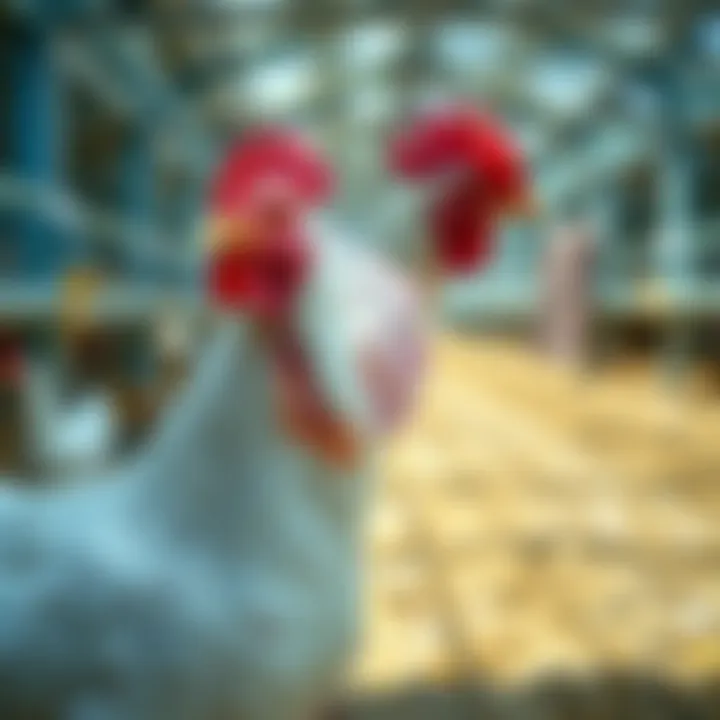
- Durability Indicators:
- Recommendations:
- Weather Resistance
- Wear Tolerance
- Maintenance Frequency
- Evaluate longevity in various conditions
- Consider the investment over time not just up front
Biosecurity Implications
Biosecurity is a major concern in poultry management. The right flooring helps keep diseases at bay, while improper materials can potentially become breeding grounds for harmful pathogens. For instance, slatted plastic flooring may provide excellent drainage, reducing moisture, which in turn minimizes bacterial growth. However, porous materials, like certain wooden types, can harbor bacteria in surfaces that are tough to clean meticulously.
Drastic measures may need to be taken regarding biosecurity if the flooring does not support ease of cleaning.
- Considerations for Biosecurity:
- Fungus and bacteria growth potential
- Ease of sanitation and cleaning
"In poultry, the tiniest oversight can lead to significant losses. It is not just about comfort but also about maintaining a healthy environment for your birds."
By being deliberate about the choices made towards flooring, poultry keepers can effectively mitigate risks and bolster overall health. The choices around durability and biosecurity are not just challenges but opportunities to enhance poultry management significantly.
Selecting the Right Flooring for Your Chicken House
Choosing the ideal flooring for a chicken house is a task that shouldn’t be taken lightly. The right flooring not only affects the cleanliness and comfort of the space but also significantly impacts the overall health and productivity of a flock. When making decisions about flooring materials, it's essential to consider several factors, including space, flock size, and local climate conditions. Each element plays a role in determining the most suitable flooring solution that meets the specific needs of your poultry operation.
Evaluating Space and Flock Size
Evaluating your space and flock size is foundational when selecting flooring. A small backyard flock has vastly different needs compared to a large commercial operation. The dimensions of your chicken house will dictate the type of flooring you can use effectively.
For instance, if you have more room and a larger flock, you might opt for materials that offer better drainage and are easier to clean, such as concrete slabs or vinyl sheets. These options work well with larger areas, allowing for efficient management of droppings and bedding. On the other hand, smaller coops often benefit from natural bedding materials like straw or wood shavings, which provide both comfort and warmth.
- Considerations for Space:
- Flock Size Implications:
- Larger spaces may allow for specific synthetic options that promote hygiene.
- Small spaces might require more traditional bedding methods that are both effective and economical.
- A bigger flock could necessitate a flooring choice that holds up against wear and tear over time.
- Smaller flocks might not cause as much wear, allowing for flexibility in material choices.
Climate Considerations
The local climate can have a profound influence on the flooring decision for chicken houses. Whether you are battling freezing temperatures or scorching heat, the right flooring helps in insulating and maintaining a stable environment for your chickens.
In Cold Climates:
Choosing flooring materials that provide insulation is vital. Natural materials like straw or wood shavings can trap heat, helping to keep chickens warm during chilly nights. They are more than just flooring; they provide comfort and warmth that can lead to healthier birds and better egg production.
In Hot Climates:
Conversely, locations with soaring temperatures may require flooring that promotes ventilation and cooling. Materials such as sand or raised plastic mesh can ensure better air circulation. These options minimize moisture retention and combat the buildup of ammonia from waste, which is critical for maintaining poultry health in hotter conditions.
- Key Elements to Consider in Climate:
- Insulation properties of the flooring for warmth in winter.
- Heat management with ventilation-focused flooring for summer.
Ultimately, understanding your specific environment and the needs of your birds will guide you toward selecting flooring that fosters a thriving chicken house. By evaluating both space and climate, you will ensure that your flooring choices support the well-being and productivity of your chickens, aligning with best practices in poultry management.
Sustainable Flooring Practices
Sustainable flooring practices are becoming increasingly vital in the poultry farming sector. These practices not only enhance the environmental footprint of chicken houses but also contribute significantly to the welfare of the birds and the efficiency of production. Adopting sustainable options encourages a holistic approach that benefits both farmers and their flocks.
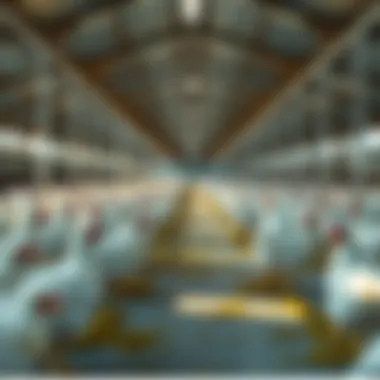
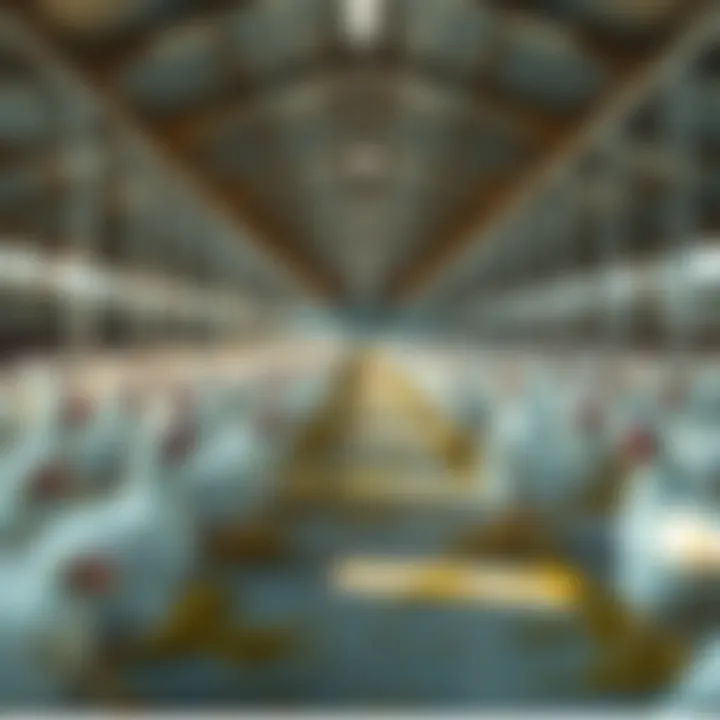
The rationale behind sustainable flooring is multifaceted. For starters, many flooring materials can be directly linked to ecological impact. Using resources that are renewable or recyclable reduces waste and lessens the dependency on virgin materials. This minimizes the environmental harm associated with production and disposal. Additionally, by implementing sustainable practices, poultry farmers can also improve the overall health and productivity of their birds, thus creating a win-win situation.
Some specifications to keep in mind include:
- Resource Management: Sustainable flooring options often utilize materials that are readily available and easier to manage without inflicting long-term damage on the ecosystem.
- Economic Viability: Investing in sustainable practices may involve initial costs, but over time, they lead to savings on waste management and increased flock health, translating to better returns.
- Animal Welfare: Properly selected sustainable flooring positively influences the comfort and health of chickens, which directly correlates to productivity levels.
"In an era where every little counts, sustainable flooring practices might just be the secret ingredient for success in poultry farming."
Recycled Materials in Flooring
Recyclable materials are a game-changer in poultry house flooring solutions. One prominent example includes recycled rubber. This material showcases impressive durability and resistance to wear and tear, making it a great candidate for high-traffic areas in chicken houses.
Beyond just rubber, there is also a wide array of plastic composites made from repurposed materials. These offer the advantage of minimizing landfill contributions while providing a reliable surface for poultry environments. Not forgetting wooden materials, which, when sourced sustainably, can also be an excellent and warm flooring option.
Key points of consideration when opting for recycled materials include:
- Durability: Ensure the material can withstand the specific load and conditions expected in a chicken house.
- Maintenance: Investigate how easy it is to clean and maintain these flooring types.
- Availability: Check the local availability of recycled solutions in your area to avoid unnecessary transport emissions.
Composting Flooring Materials
Composting is an innovative method that complements sustainable flooring practices effectively. Utilizing natural materials that can break down and nourish the soil is both eco-friendly and economically sensible. Imagine using straw or wood shavings as flooring; these can later be composted efficiently.
The benefits of composting flooring materials include:
- Nutrient Recycling: Decomposed materials lead to rich organic matter which can subsequently improve soil fertility when returned to crop fields.
- Cost Efficiency: Reducing disposable waste means lower costs related to waste removal.
- Reduction of Carbon Footprint: Composting helps cut down on methane emissions as it slows the decomposition process that typically releases greenhouse gases.
Future Trends in Chicken House Flooring
As the agricultural landscape evolves, so too does the way we approach flooring solutions in poultry management. The importance of keeping up with future trends in chicken house flooring cannot be overstated; it not only reflects the advancements in technology but also aligns with the growing emphasis on sustainability, efficiency, and animal welfare. Farmers looking to stay ahead in their operations can benefit greatly from understanding these trends. Implementing innovative technologies and smart solutions can enhance productivity, reduce maintenance costs, and improve the overall health of the flock.
Innovative Flooring Technologies
Adopting innovative flooring technologies can revolutionize how poultry houses operate. One noteworthy advancement is the introduction of eco-friendly materials that are designed to minimize environmental impact while maximizing comfort for the birds. Products made from reclaimed plastics or biodegradable composites are becoming increasingly prevalent. These materials not only provide a durable surface but also contribute to circular economy practices within farming.
Furthermore, modular flooring systems are gaining traction. These systems allow for customizable configurations that can be adjusted according to the flock size and layout changes, enabling greater flexibility. The integration of anti-slip coatings also enhances safety in the chicken house, which can prevent accidents and injuries.
Another exciting development is the use of temperature-regulating flooring. By integrating materials that can either retain warmth in colder months or reflect heat during warmer periods, chicken houses could see improvements in energy efficiency. Such innovations ensure a more stable microclimate for the chickens, fostering better growth and egg production.
"Innovation in flooring isn’t just about durability; it’s also about enhancing the environment for both the birds and the farmers."
Smart Flooring Solutions
As we enter an era of digital transformation, smart flooring solutions are beginning to make waves in poultry farming as well. These systems utilize sensors and IoT (Internet of Things) technologies to monitor the conditions of the flooring and the house environment in real-time. Smart sensors can track humidity levels, temperature fluctuations, and even the presence of waste, providing valuable data for farm management.
Such technologies allow for automated cleaning systems, which can significantly reduce the labor required in maintaining hygienic conditions. Automated waste removal systems can sweep or rake the flooring to keep it clean, minimizing the risks of disease outbreaks within the flock.
Additionally, the data collected by these smart systems can be analyzed and utilized for predictive maintenance, effectively forecasting any issues before they escalate. This not only enhances the longevity of the flooring materials but also ensures that farmers can respond quickly to changing conditions, further optimizing productivity.
In summary, as the poultry industry embraces these future trends in chicken house flooring, it’s essential for farmers to keep themselves informed and equipped. By prioritizing innovative and smart solutions, one can take significant strides toward achieving a more sustainable, efficient, and welfare-oriented operation.
Closure
In wrapping up this exploration of chicken house flooring, it’s crucial to underscore the significance of choosing the right flooring type. Flooring is not merely a base underfoot; it plays a vital role in the overall health and productivity of poultry flocks. Selecting flooring wisely can lead to improved hygiene, easier maintenance, and a more comfortable living environment for chickens.
Summary of Key Points
- Importance of Flooring: The flooring choice directly influences the welfare of the poultry, affecting their health, behavior, and productivity levels.
- Types of Flooring: From natural options like straw and wood shavings to synthetic choices like concrete and vinyl, each material comes with its pros and cons.
- Maintenance Needs: Proper care and regular cleaning are prerequisites regardless of flooring type, although some materials require more frequent attention than others.
- Sustainability: The trend towards sustainable practices continues to grow, with recycled materials and composting methods becoming increasingly relevant in poultry operations.
Final Thoughts on Flooring Selection
Choosing the optimal flooring for a chicken house is not a one-size-fits-all task. It involves careful consideration of various factors including flock size, local climate, and the specific needs of the birds. Here are some practical tips:
- Assess your specific situation. What might work well in a tropical climate could be unsuitable in a colder region.
- Consider the long-term implications of your flooring choice. The initial investment can lead to savings on maintenance and improved bird health down the road.
- Stay informed about new technologies and innovations in flooring materials. For instance, smart flooring solutions that integrate with technology can provide valuable data on conditions within the chicken house.
The decisions made today regarding flooring can have lasting impacts on flock productivity and overall farm success.







